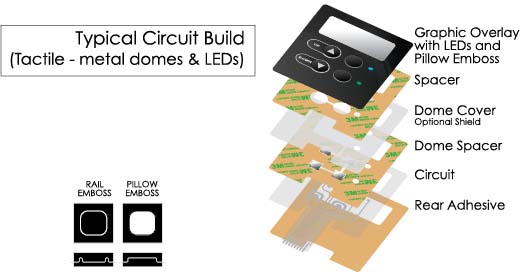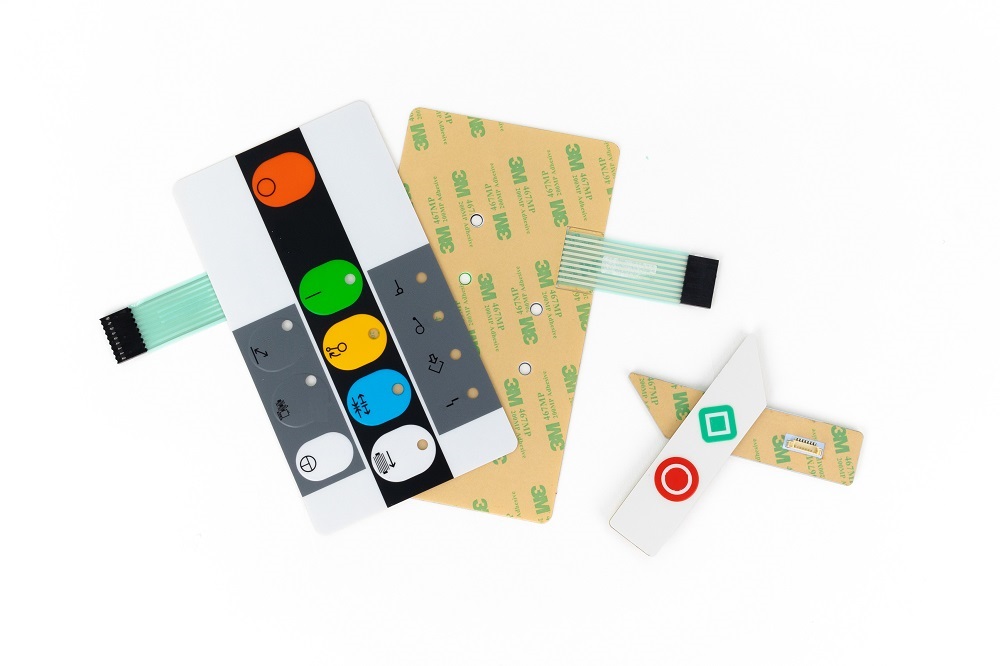Recognizing Membrane Switches: The Secret to Sturdy and Reputable Controls

What Are Membrane Buttons?
Membrane layer switches are an innovative solution in the realm of user interface modern technology, incorporating performance and style perfectly. These devices act as an interface in between individuals and electronic systems, incorporating a number of components into a portable layout. Typically constructed from flexible, thin layers of products, membrane buttons are made to react to touch, making it possible for individuals to engage with machinery and digital devices properly.
The key aspects of a membrane switch consist of a printed circuit layer, visuals overlay, and a spacer layer that protects against unintentional activation. The visuals overlay can be customized to show brand name identity or customer preferences, boosting appearances while making sure use. Membrane buttons are frequently used in various applications, including clinical gadgets, customer electronic devices, and commercial devices, owing to their resilience and resistance to environmental factors such as dampness and dirt.
One of the crucial benefits of membrane layer buttons is their capacity to withstand deterioration, making them excellent for high-traffic environments. Furthermore, they are lightweight and call for very little room, enabling ingenious designs in product development. Overall, membrane switches over stand for a practical and efficient option for modern-day digital interfaces, marrying modern technology with user-centric layout principles.
How Membrane Layer Switches Work
The operation of membrane changes rest on a basic yet effective device that converts individual input right into electronic signals. These switches contain numerous layers, usually consisting of a graphic overlay, a spacer layer, and a circuit layer. When a customer presses the button, the leading layer flaws, permitting a conductive component in the circuit layer to reach an equivalent conductive pad on the bottom of the graphic overlay. This contact shuts the circuit and sends out an electronic signal to the tool, indicating that the button has actually been triggered.
The layout of membrane layer buttons can differ, but they frequently integrate domes or tactile components to provide comments to the user, enhancing the overall experience - membrane switch. The products used in membrane switches, such as polyester or polycarbonate, contribute to their resilience and resistance index to environmental variables, consisting of dampness and dirt. Furthermore, the printed circuits are normally enveloped, which secures them from damage with time.
Advantages of Membrane Layer Switches

Furthermore, membrane layer switches are recognized for their durability. Constructed from durable products, they are immune to dirt, moisture, and physical wear, which substantially prolongs their life expectancy compared to conventional mechanical switches. This sturdiness makes them especially ideal for high-traffic environments and applications calling for longevity.
An additional significant benefit is the ease of cleansing and upkeep. The smooth surface of membrane switches over reduces dirt build-up and is usually unsusceptible spills, making them ideal for settings that call for constant sanitization.
Additionally, membrane buttons supply a streamlined profile, leading to a thinner style that can be incorporated right into numerous gadgets without adding mass. This feature not only improves the visual appeal yet likewise contributes to a more ergonomic product layout.
Applications of Membrane Layer Buttons
User-friendly and versatile, membrane layer buttons find applications across a wide variety of markets, consisting of clinical devices, customer electronic devices, and commercial equipment. In the clinical field, these switches are indispensable to devices such as analysis devices, individual monitoring systems, and mixture pumps, where reliability and ease of cleansing are critical. Their capacity to hold up against severe settings and maintain capability makes them suitable for such applications.

In customer electronic devices, membrane layer important site switches are made use of in products like microwaves, washing machines, and remote controls - membrane switch. Their smooth style permits user-friendly individual interfaces, improving the discover here general customer experience while providing durability and resistance to damage
Commercial equipment also takes advantage of membrane buttons, specifically in control panels for equipment and automation systems. These switches provide security versus dirt and moisture, ensuring consistent performance in challenging environments. Their personalized features permit makers to tailor them to particular functional requirements, enhancing efficiency and performance.
Selecting the Right Membrane Switch
When selecting a membrane button, it is important to think about various factors that influence efficiency and viability for details applications. The primary considerations include ecological conditions, responsive feedback, toughness, and style specifications.
First, evaluate the operating atmosphere; buttons subjected to wetness, chemicals, or extreme temperatures need details materials to make certain durability and functionality. Next off, assess the requirement for responsive comments. Relying on user interaction, some applications might take advantage of a responsive response to verify activation, while others might prefer a non-tactile layout for visual factors.
Sturdiness is another vital aspect; membrane layer buttons ought to be made to endure regular use, impacts, and abrasion. Ensure the selected switch can sustain the expected lifecycle, particularly in high-usage scenarios.

Conclusion
Finally, membrane switches offer as necessary parts in the style of long lasting and trusted control systems throughout different industries. Their portable layout, combined with robust building and construction and customizable functions, improves individual communication while ensuring longevity in requiring atmospheres. The flexibility of membrane layer switches over permits customized remedies that satisfy specific functional needs, enhancing their relevance in modern-day technology. As markets remain to advance, the significance of integrating efficient membrane button options can not be overstated.
Membrane layer changes stand for a critical aspect of modern-day interface layout, mixing capability with resilience in different applications.Membrane layer switches are a sophisticated option in the world of individual interface modern technology, combining performance and style flawlessly. Commonly built from adaptable, thin layers of materials, membrane switches are made to react to touch, allowing individuals to engage with equipment and electronic gadgets successfully.
The style of membrane switches can differ, but they typically incorporate domes or responsive elements to provide comments to the customer, boosting the total experience.In final thought, membrane layer changes serve as crucial parts in the style of sturdy and trusted control systems throughout various markets.